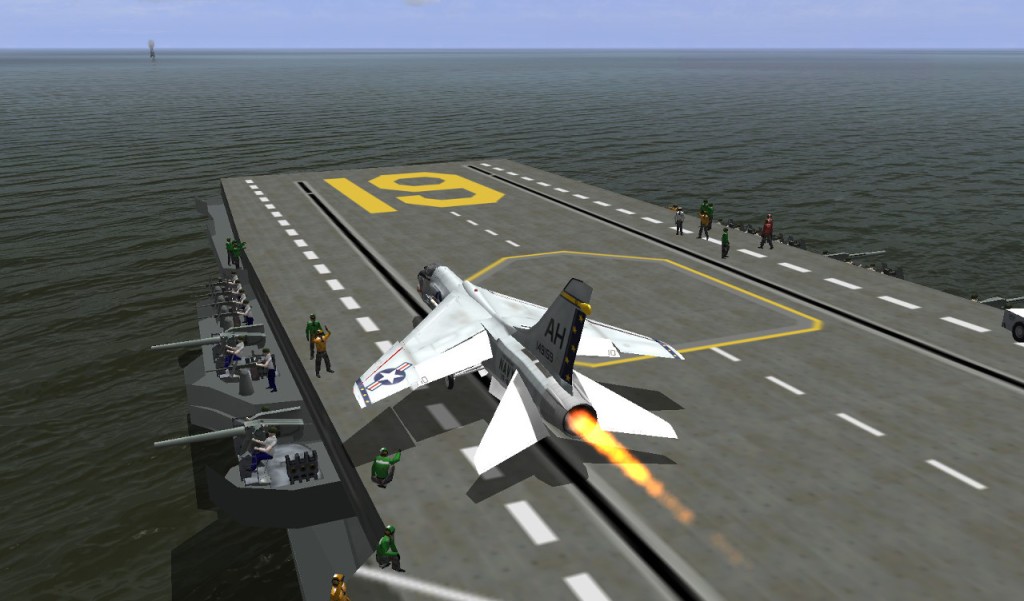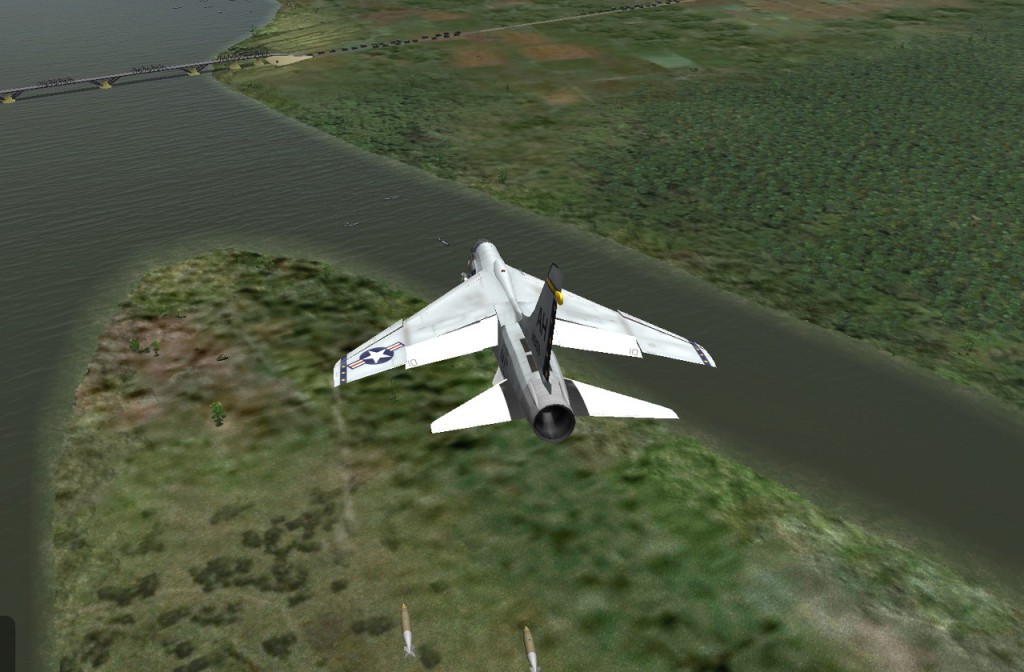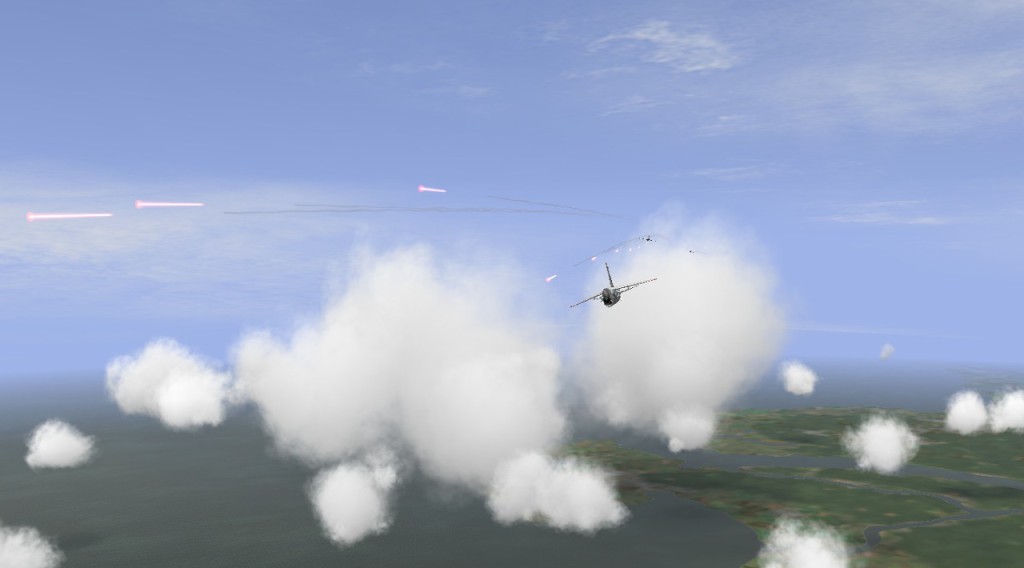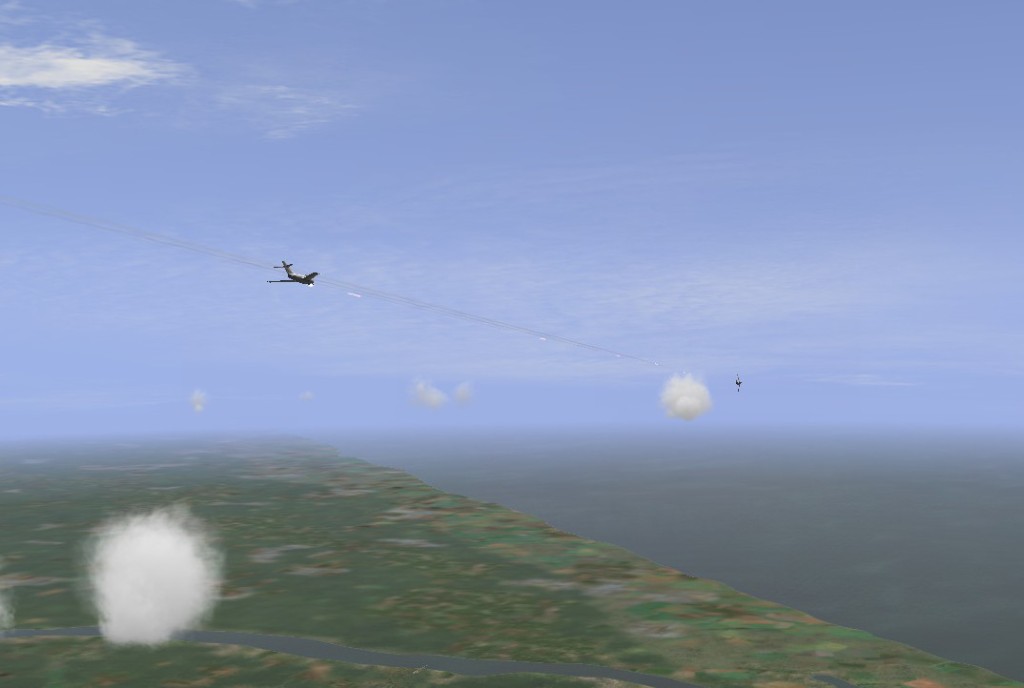Tags
BAT, Bleachers, Cold War, Gulf of Tonkin, IL-2, IL-2 Sturmovik, Vietnam
This is the eighty-first in a series of posts on the Vietnam War. See here for the previous post in the series and here to go back to the master post.
Having not really mastered the A-1 Skyraider, I’d like to modernize a tad. Essentially, I’m taking on the same program as I did with that somewhat-more-WW2-like-plane but this time I’ll go to the Vought F-8 Crusader.
The F-8 has a particular distinction with regards to my timeline of Vietnam battles. They were the aircraft flown against the attacking torpedo boats in the initial Gulf of Tonkin incident. That mission is the first in the ‘Nam War user-made mission collection and, had I had access to it a few years ago, would have been my first Vietnam mission flown.
Since I missed that opportunity then, I’ll take it now. The series approximates (as far as I can tell) actual missions and their challenges. Through the experiences of F-8 drivers we can see the escalation of the war in a different way than we did doing the same via the Skyraider.

It must go without saying that the F-8 is a very different animal than its prop-driven brother-in-arms. Also carrier-based, we are now talking jet propulsion and that offers a very different set of advantages and challenges. If nothing else, I can finally get my plane off the deck. Or I should clarify – some of the time I can. In one of my series of attempted starts with this scenario, my engine caught fire and the plane exploded on the deck – all while I was still hitched to the catapult. I still have managed to drop my ride into the drink a couple of times even though prolific application of afterburner can and has saved me from a lot of horrid launches. So… some of the time.
In this case, the difficulty of the in-game model mirrors difficulties with the aircraft. The Crusader was difficult to operate from a carrier, particular in terms of landings. On statistic shows almost 88% of all aircraft in service having been involved with mishaps of one kind or another. It nonetheless had good flying characteristics that made it, by some measures, the most successful fighter against the communist MiGs. It also had the distinction of being the last American aircraft to be designed as a gunfighter – to have the guns used as the primary weapon. The F-8 was flown during a time when it was thought guided missiles would make guns obsolete. The combination of an aircraft built for dogfighting and pilots trained to fly them as such claimed 19 MiGs down over the course of the war against only 3 losses.

I feel a little better when failing to fly well a plane that gave even experienced pilots a run for their money. However, my level of incompetence goes well beyond that. The transition to jets takes some getting used to. While the ability to accelerate and rapidly gain altitude is wonderful, I’m being flummoxed with my lack of maneuverability. A couple of attempts at a wingover or an Immelmann introduced me to the helplessness of a flat spin. Yet my troubles go beyond mere bad stick handling. My ability to think strategically – to use my aircraft to its best advantages given the situation – is about null.
I’ve been playing with the default settings, mostly, when it comes to difficulty and player aids. Exactly how this is configured seems to have changed with each new installation of BAT. Two of the default settings I fondly remember from my beginning attempts with Pacific Fighters were the appearance of the enemy on one’s map and the color/text identification of the moving blips of pixels when looking out the front windscreen (see, for example). These are no longer the default setting with the current BAT. In fact, I’m not sure they are even an optional setting anymore in BAT. If so, this was done for realism reasons. I get that – but I’m having a terrible time translating the clues that are realistically available to me into a situational awareness.
I understand the design philosophy and part of me loves it. For a good simulation, I should be working within the confines of what the historical pilot had. Yet once I get more complex than a one-on-one encounter, I am almost certain to lose my bearings.

I took a few screenshots to help illustrate my problem. These are all from ‘Nam War portrayal of the April 3rd, 1965 Rolling Thunder attack on Thanh Hóa Bridge. It centers on the unexpected attack of the escorting F-8s by four MiG-17s. The battle resulted in the first North Vietnamese air victory* against the Americans.
At some point in my version of the world I realized I’d lost all my friends and so decided to turn for home. Almost immediately I ended up with two MiGs on my tail – identified only by the bullets flying past and into my aircraft (see above). Through abject dumb luck I made a horrendous energy-bleeding turn (note the Stall in the bottom right of the below screen) that caused the enemy to overshoot and land right in my sights. It was a fantastic opportunity for which I was not prepared.

Now, the primary means of tracking the enemy, assuming one can’t actually just see them, is feedback from the targeting radar and the passive IR tracking systems. This is augmented by the perhaps even-more-useful-to-the-overwhelmed-novice-pilot aural feedback of the Sidewinder missile tracking system. In some quick-and-dirty searching, I can find neither a good illustration nor a description of the pilot interface for the aircraft’s systems. Some cockpit shots suggest there is an oscilloscope-like display mounted just below the gun sight. On screen, I get its feedback through printed messages (shown below, bottom right again). I didn’t fully appreciate it at the time, but getting one message from each means I’ve probably got one in front of me and one on my tail.

The encounter ended in tears. Again, this isn’t quite the humiliation that it felt like. At this point I was engaged in four-on-one combat against a determined enemy. Although I’d lost track of them all, I was pretty sure they’d gotten behind me. Sure enough, that was confirmed when my aircraft was shredded by close-range gunfire. I’m obviously going to need a little more than a run through of a few scenarios to climb this learning curve. I’ll note further that this was one of the last big air battles before the proliferation of North Vietnam’s deadly air defense systems.

Fortunately, just as the simulation’s capabilities have evolved, so has many other areas of support for the user. I’ve found a nice series of instructional videos done for IL-2 – many for the WWII planes but jets are featured as well. This is in addition to the ever-proliferating fountains of written and video informational resources for sim pilots, model pilots, and history buffs. I’ve barely scratched the surface but, at the same time, I am looking at resources which help identify the F-8’s advantages and disadvantages of that time and place. Sometimes it feels like a degree program is necessary to be able to jump into a scenario or two. A minimum of competency is required to enjoy this wealth of historical scenarios. It is a level of competency that I need to find.
I wanna get better.
Return to the master post for more Vietnam War articles. To zoom out your view and see the big picture, click here.
*Based on gun camera footage, a MiG pilot claimed a kill on one of the Crusaders. Per U.S. records, all of the Crusaders were successfully returned by their pilots. However, one of the aircraft was indeed damaged and it was diverted from its carrier to Da Nang. Upon landing, it was apparently written off as destroyed. This would, in fact, credit the communist air force with a victory.

Pingback: Giggity | et tu, Bluto?
Pingback: Pulled My Trigger, Now He’s Dead | et tu, Bluto?
Pingback: Alpha Strikeout | et tu, Bluto?
Pingback: Nothing Equals the Splendor | et tu, Bluto?
Pingback: Grounded | et tu, Bluto?